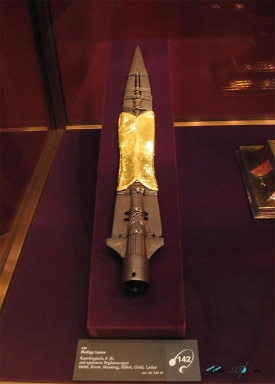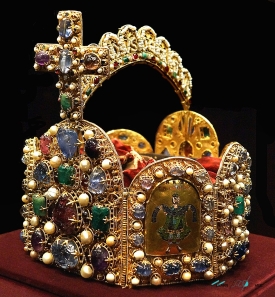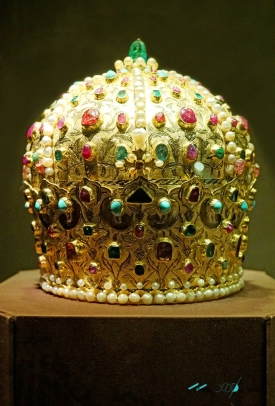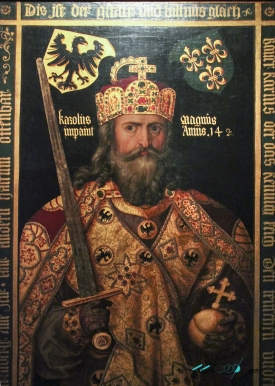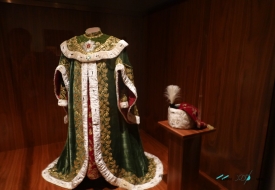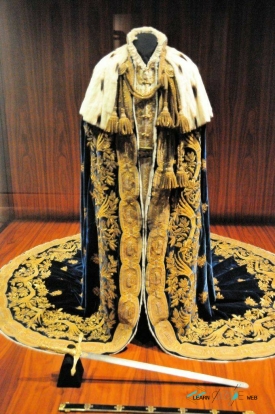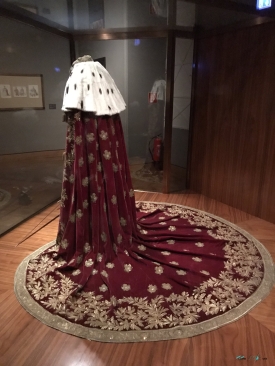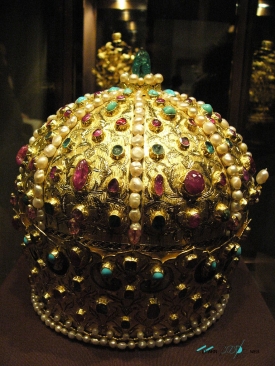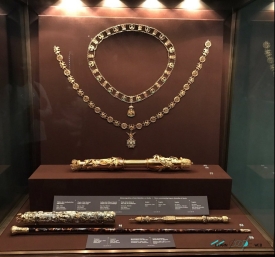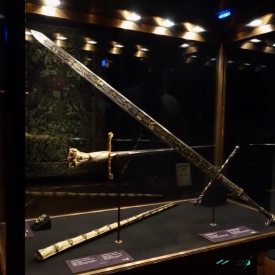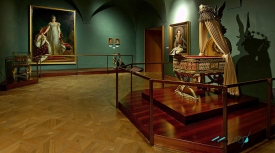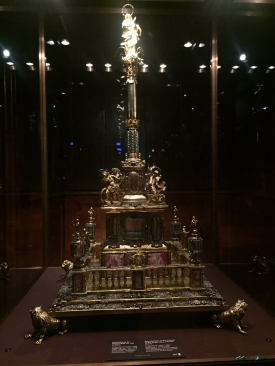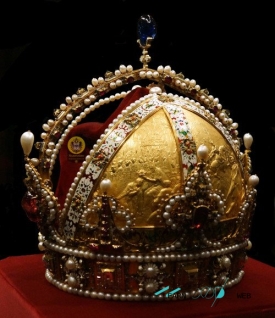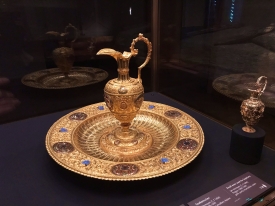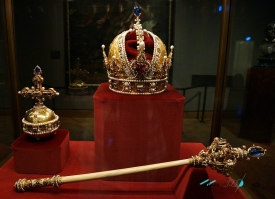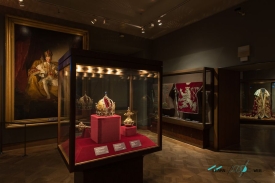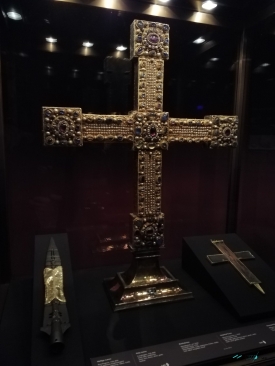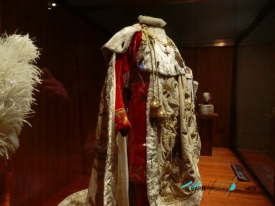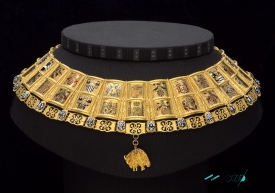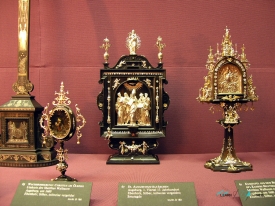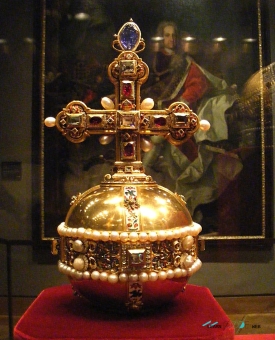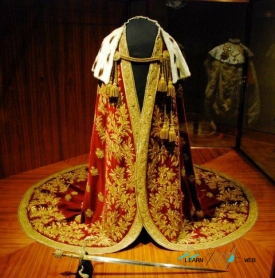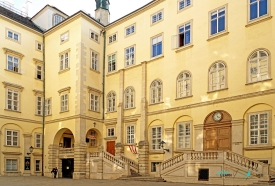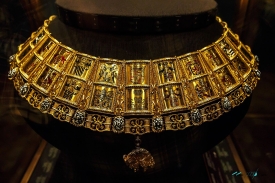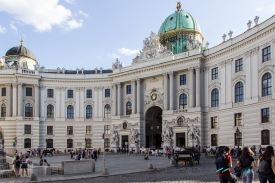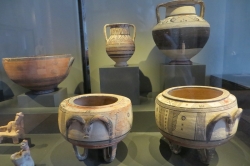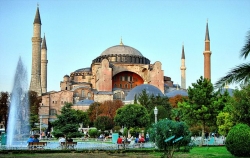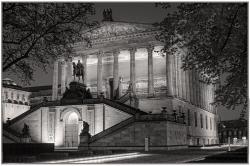ABOUT Imperial Treasury Vienna
The Schatzkammer, the Imperial Treasury, is exhibited in the Hofburg Palace in Vienna, it is part of the old collections of the House of Habsburg in which objects of the greatest dynastic or religious importance were kept. The exhibition, which has a total of 23 rooms, is divided into a spiritual and a secular treasure. It is one of the most important collections of its kind. The collection spans over a thousand years of European history.
The secular collection contains numerous imperial artifacts from the House of Habsburg, including crowns, royal regalia, jewelry, precious stones, such as the clothing worn by the Holy Roman and Austrian Emperors. One of the most important pieces is the Sword of Charlemagne. Like all secular treasures, it was designed to testify to the power of the sovereign. The ecclesiastical collection contains numerous religious treasures, such as the supposed "Holy Spear", among other relics of Christianity and objects ascribed to the private property of the saints.
In 1556, Ferdinand I brought the art expert Jacopo Strada from Nuremberg to the Hofburg in Vienna as his court antiquary and administrator of the imperial treasury. At the time, the imperial collections were a motley mix, and the division into painting, crafts, religious objects, and insignia was not made until the mid-18th century. The storage place was traditionally the Augustinian monastery.
Under Maria Theresa, the Crown Treasury was separated from the rest of the Habsburg collections and placed in the rooms of the Hofburg, where the Spiritual Treasury is located today. There was a suspicion that this repositioning was intended to distract attention from the fact that part of the Habsburg Kunstkammer was being sold or minted to finance Maria Theresa's wars against Prussia. In 1800, the imperial jewels of the Holy Roman Empire (which had been brought to Regensburg from Nuremberg and Aachen in 1796 to protect them from Napoleon's troops) were deposited in the Viennese treasury, where they remain to this day.
In 1871, the imperial collections were reorganized and the Viennese Treasury Chamber was also redesigned. The Empire and Austrian jewels were later presented to the public in parallel with the exhibition of other Habsburg collectibles at the Natural History Museum (opened in 1889) and the Art History Museum (opened in 1891). At that time, public access to the treasury was under the dome of the Michaelertrakt. The propagandistic purpose of emphasizing the supremacy of the dynasty in Central Europe undoubtedly played a role in the display of the imperial jewels.
A few days before his renunciation of "any participation in the affairs of state" on November 11, 1918, Emperor Charles I left a series of objects that were considered personal belongings of the Habsburg-Lorraine family, mainly jewels and pieces of jewelry. , but also the Florentine diamonds and the empress's diamond crown: extracted from the treasury by a family confidant and taken to Switzerland.
With the end of the monarchy in 1918, the treasure lost its political purpose and became a pure museum. In the exhibition that opened in 1928 under the direction of Arpad Weixlgärtner and which included two more rooms than the previous one, objects that had not been shown before for political reasons could also be seen for the first time. These included the insignia of the Kingdom of Lombardy-Venice (the monarchy did not want to commemorate the loss of this) and objects belonging to Emperor Maximilian of Mexico.
The imperial jewels of the Holy Roman Empire were brought to Nuremberg by the National Socialist regime in 1938 and exhibited in the church of St. Catherine. They were returned to Vienna by the American occupation forces after World War II and have been on display in the treasury since 1954.
In the years 1952 to 1954, the treasury was reorganized, and the objects were grouped more thematically than before, a room on the function of the Habsburgs as archdukes of Austria, as Roman-German emperors, as emperors of Austria, etc.
The secular collection contains numerous imperial artifacts from the House of Habsburg, including crowns, royal regalia, jewelry, precious stones, such as the clothing worn by the Holy Roman and Austrian Emperors. One of the most important pieces is the Sword of Charlemagne. Like all secular treasures, it was designed to testify to the power of the sovereign. The ecclesiastical collection contains numerous religious treasures, such as the supposed "Holy Spear", among other relics of Christianity and objects ascribed to the private property of the saints.
In 1556, Ferdinand I brought the art expert Jacopo Strada from Nuremberg to the Hofburg in Vienna as his court antiquary and administrator of the imperial treasury. At the time, the imperial collections were a motley mix, and the division into painting, crafts, religious objects, and insignia was not made until the mid-18th century. The storage place was traditionally the Augustinian monastery.
Under Maria Theresa, the Crown Treasury was separated from the rest of the Habsburg collections and placed in the rooms of the Hofburg, where the Spiritual Treasury is located today. There was a suspicion that this repositioning was intended to distract attention from the fact that part of the Habsburg Kunstkammer was being sold or minted to finance Maria Theresa's wars against Prussia. In 1800, the imperial jewels of the Holy Roman Empire (which had been brought to Regensburg from Nuremberg and Aachen in 1796 to protect them from Napoleon's troops) were deposited in the Viennese treasury, where they remain to this day.
In 1871, the imperial collections were reorganized and the Viennese Treasury Chamber was also redesigned. The Empire and Austrian jewels were later presented to the public in parallel with the exhibition of other Habsburg collectibles at the Natural History Museum (opened in 1889) and the Art History Museum (opened in 1891). At that time, public access to the treasury was under the dome of the Michaelertrakt. The propagandistic purpose of emphasizing the supremacy of the dynasty in Central Europe undoubtedly played a role in the display of the imperial jewels.
A few days before his renunciation of "any participation in the affairs of state" on November 11, 1918, Emperor Charles I left a series of objects that were considered personal belongings of the Habsburg-Lorraine family, mainly jewels and pieces of jewelry. , but also the Florentine diamonds and the empress's diamond crown: extracted from the treasury by a family confidant and taken to Switzerland.
With the end of the monarchy in 1918, the treasure lost its political purpose and became a pure museum. In the exhibition that opened in 1928 under the direction of Arpad Weixlgärtner and which included two more rooms than the previous one, objects that had not been shown before for political reasons could also be seen for the first time. These included the insignia of the Kingdom of Lombardy-Venice (the monarchy did not want to commemorate the loss of this) and objects belonging to Emperor Maximilian of Mexico.
The imperial jewels of the Holy Roman Empire were brought to Nuremberg by the National Socialist regime in 1938 and exhibited in the church of St. Catherine. They were returned to Vienna by the American occupation forces after World War II and have been on display in the treasury since 1954.
In the years 1952 to 1954, the treasury was reorganized, and the objects were grouped more thematically than before, a room on the function of the Habsburgs as archdukes of Austria, as Roman-German emperors, as emperors of Austria, etc.
The Best Pictures of Imperial Treasury Vienna
Videos of Imperial Treasury Vienna







